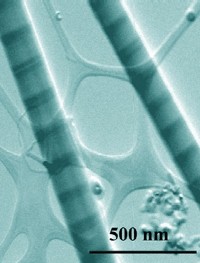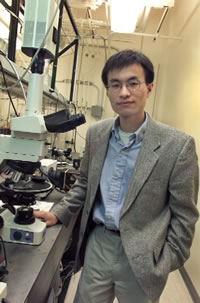|
Today's top computer chips can cram about 40 million transistors onto
a square of silicon no bigger than a postage stamp. That same size chip,
however, might hold billions of transistors in the future world of nanometer-sized
devices.
A critical step towards realizing that future has been taken by Berkeley
Lab researchers who have developed nanowires composed of two different
semiconductors -- silicon and silicon germanium alloy -- in discrete alternating
segments, like the different flavored stripes of a candy cane. These striped
or "superlatticed" nanowires can function as transistors, LEDs
(light-emitting diodes) and other optoelectronic devices, biochemical
sensors, heat-pumping thermoelectric devices, or all of the above, along
the same length of wire.
|
 |
 |
|
|
 |
In this image taken with a scanning
transmission electron microscope, two nanowires feature alternating
bands of silicon (light) and a silicon germanium alloy (dark), which
form interfaces that could be made into transistors, LEDs, and other
types of electronic devices. Each wire is less than a hundredth the
diameter of a human hair. |
|
|
"The success of today's two-dimensional semiconductor integrated
circuits has largely hinged upon carefully controlled doping and interfaces,"
says Peidong Yang, a chemist with Berkeley Lab's Materials Sciences Division
and a professor of chemistry at the University of California at Berkeley
(UCB), who led this research. "Our technique puts that same controlled
doping and interfaces within one-dimensional nanostructures."
For the past 35 years, microcircuit manufacturers have been able to double
the number of transistors on a silicon computer chip every 18 months --
a shrinkage rate known as "Moore's Law" after the Intel Corporation's
cofounder, Gordon Moore, who was first to call attention to the trend.
The smallest features of today's transistors now measure about 100 nanometers
across (about four millionths of an inch), but within the decade entire
transistors are expected to shrink to this size. That may be as small
as microtechnology can get.
Two-dimensional microchips have been likened to sandwiches, in that they
are made by depositing layers of different types of semiconductors with
different electrical properties on a wafer of silicon. It is the interfaces
between these different layers that control the flow of electrons and
enable transistors and other electronic components to function. Now, Yang
and his team can offer the same electronic diversity of a microchip in
a one-dimensional nanoscale platform.
"This is a major advancement in the field of one-dimensional nanostructure
research," says Yang. "It gives us the ability to create various
functional devices, such as p-n junction, a coupled quantum dot structure,
or a bipolar transistor, on a single nanowire, which can then be used
as a building block for constructing more complex systems such as electronic
circuits, LEDs, and thermoelectrics."
Other research groups have been able to make nanowires out of a single
type of semiconductor and have even created interfaces by criss-crossing
two or more wires made from different semiconductors. The striped nanowires
of Yang and his group offer much more ideal interfaces and are are much
better suited for commercialization. Working inside a 2.5 centimeter (one
inch) tube furnace, they grow their wires using a hybrid "pulsed
laser-ablation/chemical vapor-deposition" process.
A silicon wafer coated with a thin layer of gold is introduced into the
furnace. When the furnace is sufficiently heated, the gold film forms
a liquid alloy with the silicon and spontaneously breaks up into nanometer-sized
droplets. Vapors of the two semiconductors will then condense around the
gold droplets as deposits, which become nanowire segments. Chemicals are
used as the source of the silicon vapor and a laser is used to vaporize
the germanium. When the laser is off, only silicon is deposited on the
gold particles; when the laser is on, both silicon and germanium are deposited.
Explains Yang, "By periodically turning the laser on and off --
and this can be readily programmed -- we can form a silicon and silicon
germanium superlattice on every individual nanowire in a block-by-block
fashion. The entire growth process resembles the living polymerization
synthesis of a block copolymer."
Yang also says the use of two independent vaporization techniques, unique
to his research effort, enables him and his group to achieve "remarkable
periodicity" for their blocks of silicon and silicon germanium. The
technique is efficient and cheap. In just one hour they can make millions
of striped nanowires at a relatively small cost.
|
 |
 |
|
|
| Peidong Yang |
|
| |
|
The potential of these tiny wires is enormous. Striped nanowires might
one day be assembled into complex circuits and faster computer chips.
They might also serve as nanoscale light-emitting sources that could be
integrated into light-speed optocommunication systems. Striped nanowires
could even serve as powerful sensors of chemical and biological agents.
Contact with extremely low concentrations of a chemical or biological
agent is enough to cause a change in the electronic state of a striped
nanowire, which can be used to identify the agent.
"We are not there yet for many of these potential applications,
but we have developed a powerful platform on which a tremendous amount
of opportunities will be explored," says Yang.
Additional information:
|

